Mastering Sailboat Rudders & Steering Systems
In a Nutshell
A boat’s rudder is more than just a steering device; it's a critical part of how the vessel handles. Whether you have a modern spade rudder or a classic keel-hung one, its design dictates everything from how your boat feels under sail to how it maneuvers in a tight marina. Getting a good grasp of the different sailboat rudders out there—inboard vs. outboard, balanced vs. unbalanced—is key for any sailor who wants to truly understand their boat and stay safe out on the water.
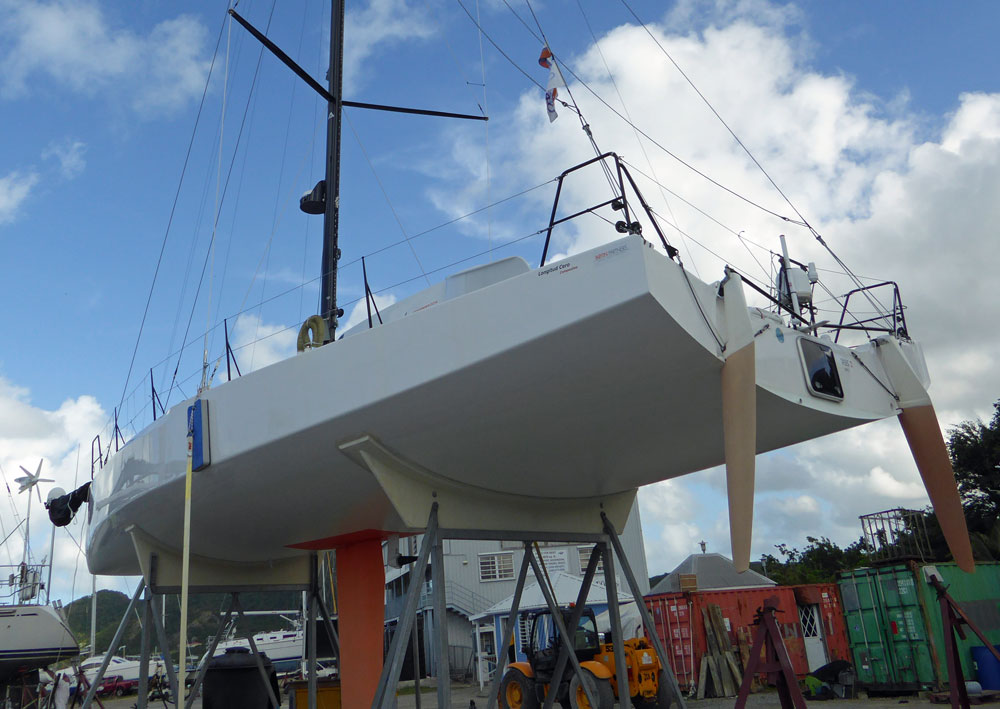 These twin high-aspect ratio rudders on an all-out race boat are clearly optimised for their hydrodynamic performance rather than their robustness
These twin high-aspect ratio rudders on an all-out race boat are clearly optimised for their hydrodynamic performance rather than their robustnessTable of Contents
- What are the main types of sailboat rudders?
- How do inboard & outboard rudders differ?
- What is the role of rudder balance?
- How do different mounting types affect performance & safety?
- What materials are used in rudder construction?
- How does a rudder's shape & design influence its efficiency?
- What about sailboat steering systems?
- Maintenance & Repair for Sailboat Rudders
- Rudder Design & Performance Trade-offs
- Emergency Steering & Contingency Plans
- Rudder & Steering System Troubleshooting
- Frequently Asked Questions about Rudders
What are the main types of sailboat rudders?
You can't really sail without a rudder, but you might be surprised at just how many different kinds there are. The types of rudders on a boat are usually pretty easy to spot, even if you’re just walking around a boatyard in the off-season. They're typically categorized in three different ways:
- Inboard & Outboard: This is a simple one. Does the rudder stock go through the bottom of the hull? Then it's an inboard rudder. If it hangs off the back, it's an outboard rudder.
- Balance: This affects how much work it takes to steer. Rudders can be unbalanced, balanced, or semi-balanced.
- Mounting: This is all about how it’s attached. You’ll see them as keel-hung, skeg-hung, transom-hung, or spade rudders. Each type has its own pros and cons.
Let's break down each type and explore what makes them tick.
How do inboard & outboard rudders differ?
The difference between inboard and outboard rudders is pretty straightforward. An inboard rudder's stock passes through the boat’s hull, while an outboard rudder hangs externally. On my first boat, an Etap 22, the outboard rudder was great because I could just lift it off the transom for a quick check or repair, even with the boat in the water. That accessibility is a huge plus.
Most modern cruising & racing yachts use inboard rudders. They're great because they’re protected by the hull and have a more streamlined design. Plus, if you have wheel steering, an inboard rudder is a must, since the steering quadrant is mounted directly to the rudderstock inside the boat.
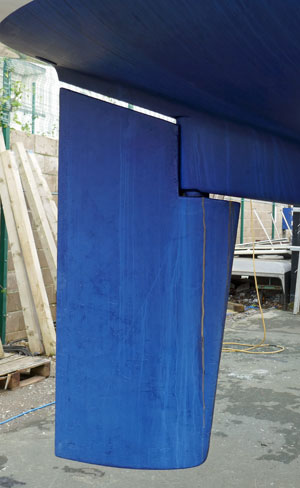 An Inboard Rudder
An Inboard Rudder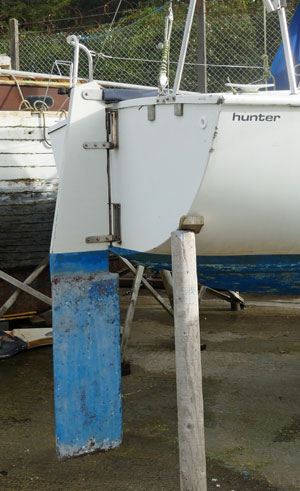 A transom-hung outboard rudder
A transom-hung outboard rudderWhat is the role of rudder balance?
Rudder balance is all about how much of the rudder blade sticks out in front of its turning axis. This is what makes the helm feel heavy or light. An unbalanced rudder has all of its surface area behind the axis. When you turn it, all that water pressure hits one side, making you feel it in the tiller. It can be a real workout, especially on a large boat.
A balanced rudder is different. Part of its blade is forward of the axis. When you turn it, the water pressure on that forward section helps cancel out the pressure on the back part. This makes the helm a lot lighter & easier on the helmsman. A semi-balanced rudder, often with a half-length skeg, is a nice compromise, offering good protection with less steering effort.
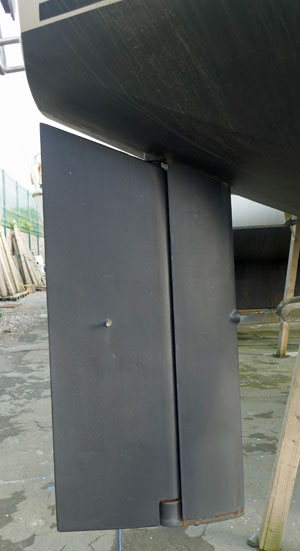 An unbalanced rudder
An unbalanced rudder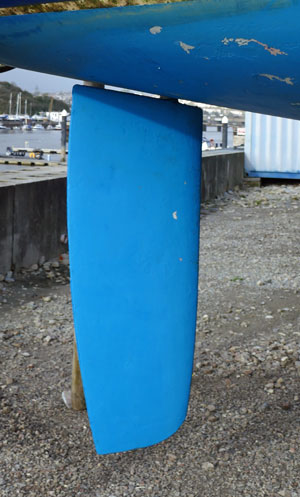 A balanced spade rudder
A balanced spade rudder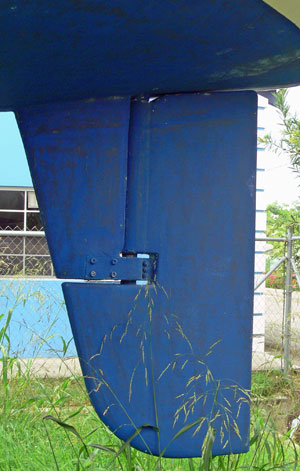 A semi-balanced rudder, partially supported by a half-skeg
A semi-balanced rudder, partially supported by a half-skegHow do different mounting types affect performance & safety?
The way a rudder is attached to the hull has a major impact on how the boat handles and how protected it is.
| Rudder Type | Description & Characteristics | Use Case & Performance |
|---|---|---|
| Keel-Hung Rudder | Attached to a full-length keel, often with a bronze or stainless steel shoe. | Found on older, heavy-displacement cruisers. Offers excellent protection but poor maneuverability in close quarters. |
| Skeg-Hung Rudder | Supported by a separate fin (skeg) built into the hull. | Provides strong protection from impacts while allowing for a better hydrodynamic shape than a keel-hung design. Common on offshore cruisers. |
| Transom-Hung Rudder | Attached to the transom with pintles & gudgeons. | Typical on dinghies & some small cruisers. Easy to remove and repair, but can be vulnerable in following seas. A Sadler 25 I once sailed had a hybrid design, incorporating a skeg for additional security. |
| Spade Rudder | A cantilevered fin with no support along its leading edge. | The most hydrodynamically efficient type. Now the norm on modern racing & performance-cruising yachts due to its responsiveness & low drag. Requires robust engineering to prevent structural failure. |
What materials are used in rudder construction?
Building a modern rudder is a pretty sophisticated process. They usually start with a sturdy metal frame (often stainless steel, aluminum, or even carbon fiber) on a rudder stock, which forms the rudder’s "skeleton." This frame is then covered with a core material and a tough fiberglass skin.
The core material is chosen based on what the rudder is for:
- Foam Cores: These are lightweight & buoyant, usually made of PVC or polyurethane. They're great for most cruising boats because if a seal ever fails, the rudder won't sink.
- Balsa Wood Cores: A traditional option that offers good strength but is vulnerable to water damage. This is a common issue on older boats, where water can get in and cause rot.
- Carbon Fibre Cores: The best choice for high-performance racing yachts. They’re super strong & incredibly light, but they'll cost you.
How does a rudder's shape & design influence its efficiency?
A rudder’s shape isn't random; it's a carefully engineered foil designed to get the most lift for the least drag. Here are a couple of key ideas:
- Aspect Ratio: This is the ratio of the rudder's depth to its width. High-aspect ratio rudders are deep & narrow—perfect for racers because they're super efficient. Low-aspect ratio rudders are shorter and wider, offering more stability, which is what you'll find on most traditional cruisers.
- End-Plate Effect: The hull itself acts like a big "end-plate" for the rudder. The smaller the gap between the rudder & the hull, the more efficient the rudder is. This is why spade rudders are designed to fit so snugly against the hull.
What about sailboat steering systems?
The rudder is only half the story; the steering system that controls it is just as important. The two most common types are:
- Tiller Steering: This gives you direct feedback from the rudder, so you can really feel what the boat's doing. It's simple, reliable, and light, but can be hard work and takes up space in the cockpit. It's typically paired with outboard rudders on smaller boats.
- Wheel Steering: This is more common on larger yachts with inboard rudders. It makes steering easier on long trips, but you lose some of that direct feel. It also has more mechanical parts, like pulleys, cables, & chains, that can wear out.
But here's a topic bound to start a heated discussion at any yacht club bar—Tiller Steering vs Wheel Steering...
Maintenance & Repair for Sailboat Rudders
Keeping your rudder in great shape is essential for both performance & safety. I always make sure to do a thorough check during haul-out. Here's what you should look for:
- Inspection: Check the pintles & gudgeons on transom-hung rudders, and the rudderstock & bearings on all inboard rudders for any signs of wear, corrosion, or play.
- Anti-fouling: Don't forget to apply anti-fouling paint! It helps keep marine growth off the rudder, which can slow you down and affect steering. Just make sure the paint is compatible with your rudder's material.
- Damage Check: Look for any cracks, blisters, or signs of delamination in fiberglass rudders, especially around the rudderstock where stress is highest.
Rudder Design & Performance Trade-offs
We’ve talked about the different rudder types, but it's worth getting into some of the more specific design choices that affect a boat's performance. One of the biggest advancements in modern yacht design is the use of twin rudders. You'll see these on wide-sterned racing boats & performance cruisers, & they have a few great benefits:
- Enhanced Control: When a boat heels over, a single, deep rudder can lose its grip. Twin rudders, being shallower, stay fully in the water, giving you excellent control even when you’re heeling way over.
- Reduced Drag: They can be designed with a smaller surface area, which means less drag & more speed.
- Simpler Rudder Stock: The load is spread between two shorter rudder stocks, which can be simpler & lighter to engineer.
Of course, they're more complex to install, need two sets of bearings, and might be more prone to snagging lines or debris. The choice between a single spade rudder & twin rudders is a big one, balancing steering efficiency & structural complexity.
Understanding the role of the rudder is key to a boat's handling, but it's just one piece of the puzzle. For a full breakdown of how a sailboat's overall design, including its keel & sail plan, affects its performance, check out our guide on "Mastering Sailboat Design Ratios & Regulation for Performance & Safety".
Emergency Steering & Contingency Plans
You never want to think about your rudder failing, but as a sailor, you know it's a possibility offshore. Whether you hit a submerged object or your rudder stock gives out under stress, being prepared with a plan is just plain smart—it could even save your life.
Holding the RYA Offshore Yachtmaster qualification, I can't stress this enough. I always carry a personal emergency kit that includes heavy-duty line, spare blocks, & some thick warps that I can use to jury-rig a temporary steering system.
There are a few widely-used methods for emergency steering:
- Drogue or Sea Anchor: You can deploy a drogue or sea anchor off the stern to help the boat track straight.
- Bucket or Warp Steering: This is a simple trick where you pass a rope through a bucket or tie it to a sail bag & trail it from the stern. By moving the warp from side to side, you can create enough drag to turn the boat.
- Emergency Tiller: A lot of wheel-steered boats have a fitting for an emergency tiller. It lets you steer manually by connecting a tiller directly to the rudder stock.
Practicing these methods is a crucial part of any offshore sailing preparation.
Rudder & Steering System Troubleshooting
A well-maintained steering system is essential for your safety & for your boat's performance. Here are some common problems and their possible causes:
Heavy Helm:
- Marine Growth: Fouling on the rudder blade creates a lot of drag.
- Worn Bearings: A stiff helm often means your rudder bearings are worn or aren't lubricated properly.
- Incorrect Balance: If you've just installed a new rudder, its balance point might be off.
Rudder Play:
- Pintle & Gudgeon Wear: For transom-hung rudders, too much play can mean the pintles & gudgeons are worn out.
- Rudderstock Bearings: For inboard rudders, play in the stock is a serious issue that needs immediate attention.
"Rudder Buzz" or Vibration:
- Cavitation: This is a classic sign of rudder cavitation, which happens when the rudder blade is pushed too hard or has an improper shape.
- Bent Rudderstock: A bent or damaged rudderstock can also cause a vibration, especially at speed.
Just remember, regular checks on all steering components will help you avoid a major problem down the line.
This article was written by Dick McClary, RYA Yachtmaster and author of the RYA publications 'Offshore Sailing' and 'Fishing Afloat', member of The Yachting Journalists Association (YJA), and erstwhile member of the Ocean Cruising Club (OCC).
Frequently Asked Questions about Rudders
What is the purpose of a skeg?
What is the purpose of a skeg?
A skeg is a part of the hull that’s built in to support & protect the rudder. It adds strength and security.
How do I know if my rudder needs maintenance?
How do I know if my rudder needs maintenance?
Look for any "play" or extra movement. Listen for creaking or groaning sounds, and check for cracks or blisters on the rudder itself. If the rudder feels heavy or unresponsive, that could also mean there's an issue with the bearings or too much marine growth.
What is the end-plate effect on a sailboat rudder?
What is the end-plate effect on a sailboat rudder?
The end-plate effect is a cool bit of hydrodynamics. The hull acts like a big end-plate, which reduces turbulence and makes the rudder more efficient. That's why you want a really small gap between the rudder and hull.
Recent Articles
-
Yacht Clearance in the Caribbean: A Sailor's Guide
Nov 25, 25 07:13 AM
Navigating yacht clearance in the Caribbean is essential for a smooth sailing trip. This guide, written by an experienced sailor, explains the required papers, procedures & tips for a hassle-free expe… -
Beneteau Oceanis 36CC: Specs, Ratios & Cruising Suitability
Nov 25, 25 06:08 AM
Detailed analysis of the Beneteau Oceanis 36CC centre cockpit sailboat. Includes design ratios, full specifications, and practical assessment of its suitability for experienced offshore and liveaboard… -
Essential Boat Toilet Maintenance & Systems: A Sailor’s Guide
Nov 24, 25 01:17 PM
Master boat toilet maintenance, from manual sea heads to 12v electric systems. Get an experienced offshore sailor’s guide on avoiding clogs, leaks, & bad smells.












